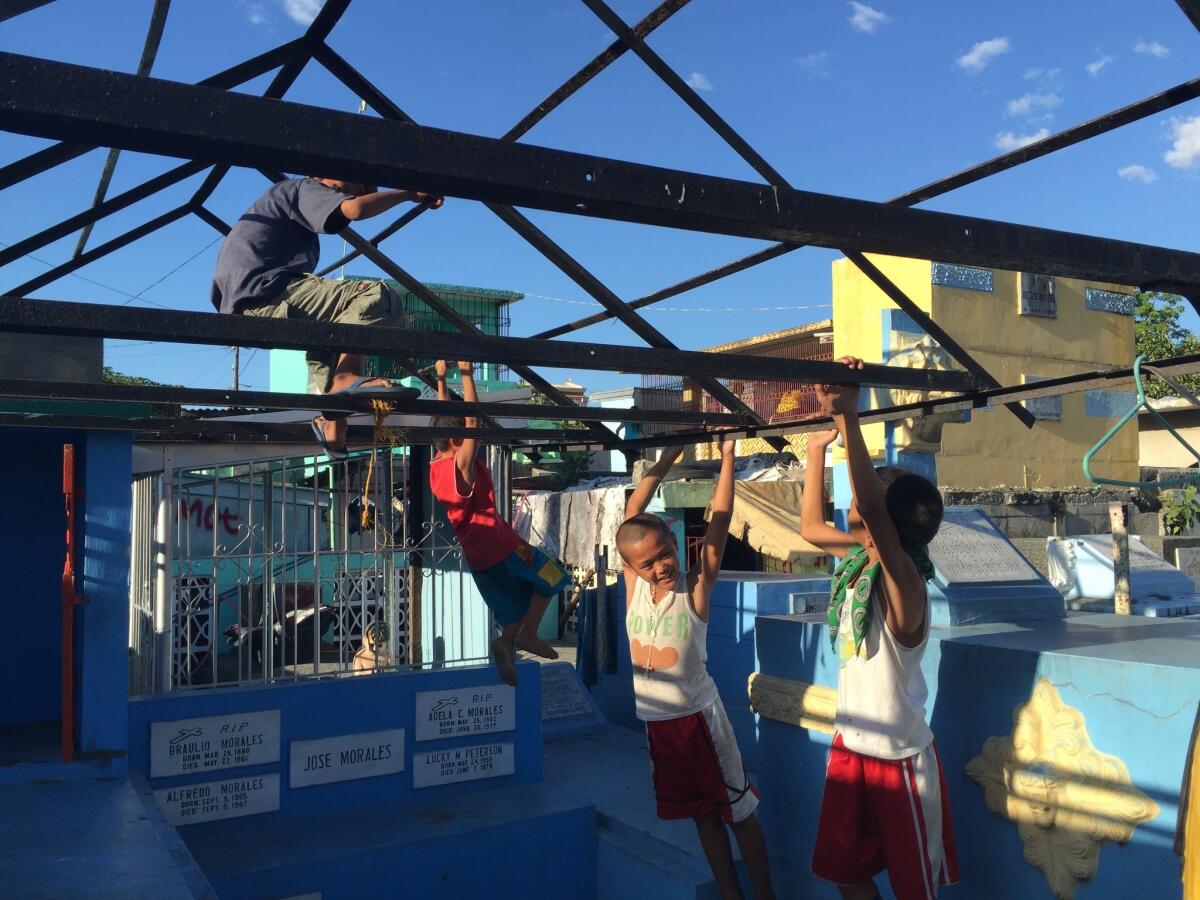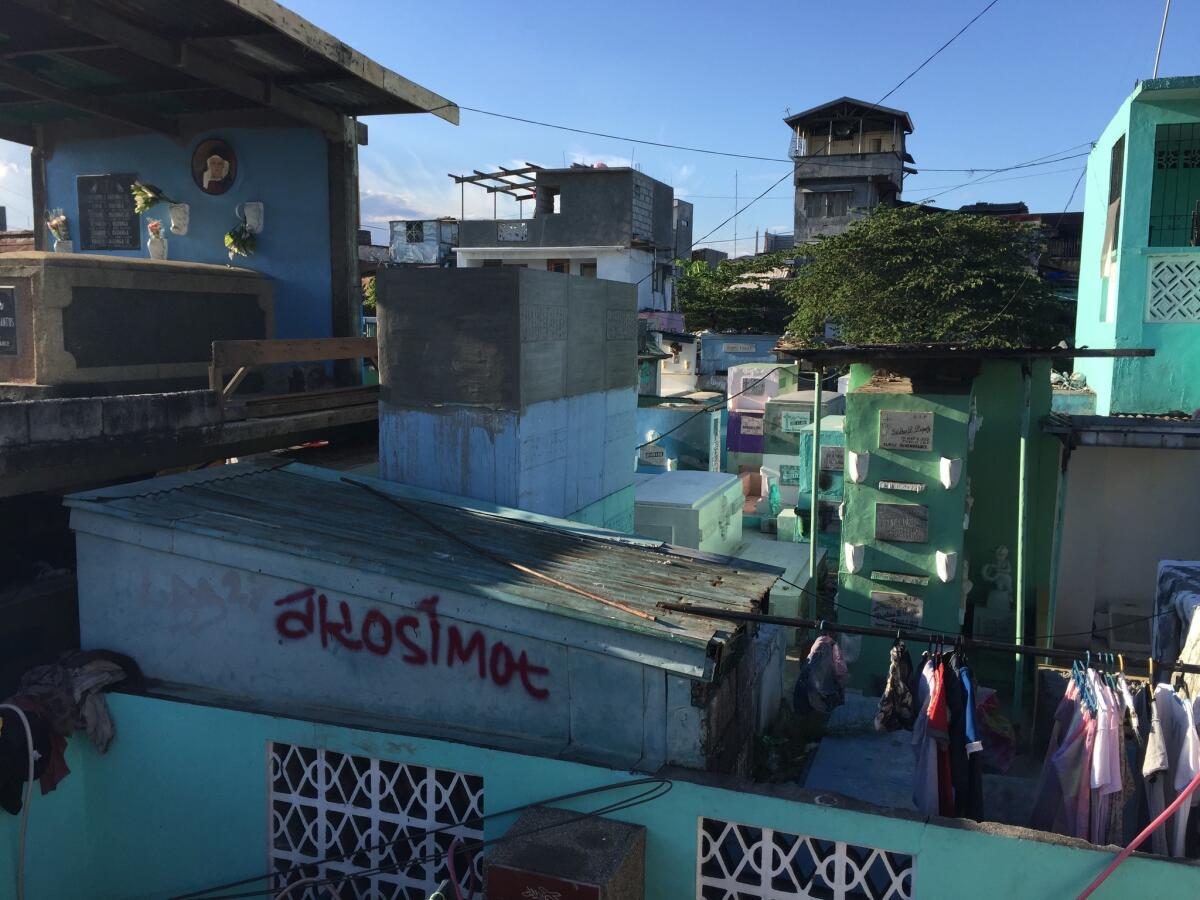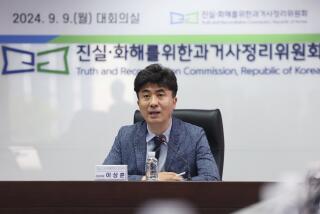The Philippines has 1.8 million abandoned children. Here’s what keeps many from adoption

- Share via
Reporting from Manila — The Manila North Cemetery, where Michelle Sambalilo was abandoned as a young child, is a sprawling, trash-strewn squatter camp where thousands of people eat, sleep and play among acres of colorful crypts.
Rescued from life among the dead, Sambalilo then lived for years among the Philippine capital’s notoriously negligent state-run shelters.
Throughout, she dreamed of someday belonging to a family of her own. But in the end, all it took was one document — one blow from the country’s adoption authorities — to send her dreams crashing down to earth.
The Philippines has an abandoned children problem. About 1.8 million children in the country, more than 1% of its entire population, are “abandoned or neglected,” according to the United Nations’ Children’s Rights & Emergency Relief Organization. Some are victims of extreme poverty; others of natural disasters and armed conflicts in the country’s riven south.
The Department of Social Welfare and Development is responsible for ensuring that many of these children find homes. (Some end up overseas — American families adopted 1,350 Filipino children between 2009 and 2015, according to the U.S. State Department).
Yet the country’s adoption bureaucracy is so forbidding that scores of aspiring adoptive parents are left in the cold, and abandoned children left to grow up without parents.
In 2014, a privately funded child care agency prepared to place Sambalilo with an American adoptive family. Then the country’s Department of Social Welfare and Development determined that she was 15 years old, two years older than previously assumed -- and too old to be adopted. It denied her application.
“My dream was to be adopted, so that someone will love me,” Sambalilo said on a sweltering morning in early May, staring down at her polka-dotted pajama bottoms and anxiously grasping her hands. She is now a slight 18-year-old with full cheeks and a shy smile. “When I found out I was too old to be adopted, I was really sad, because I really wanted to have a family.”
Then she looked off to the side, wiped away her tears, and said nothing.

“I’m just continuously worried that the government feels these children are not the priority,” said Eric Mallonga, a British-educated family lawyer and founder of Meritxell Children’s Home, the agency that is sheltering Sambalilo.
“These children are not prioritized, they’re always on the back burner, and so more children are lost to crime, to prostitution, to neglect, and a lot of street families are growing.”
He said that orphanages in the Philippines are scarce and poorly staffed; that government agencies frequently demand documents that are impossible to procure; and that even with the necessary paperwork, simple procedures can drag on for months.
Many of the children who come into his care remain there for three to four years before they are legally cleared for adoption.
“It’s ineptitude on the part of many, many social workers,” he said. “Incompetence and ineptitude.”
It’s unfair. Even if we’re over 15, you should still adopt us, because we still need a family, and someone who will love us.
— Michelle Sambalilo
Alita C. De Ocampo, a social worker in charge of the Department of Social Welfare’s Adoption Resource and Referral Section for Metropolitan Manila, said in a phone interview that she is one of two social workers in the area – a city of nearly 12 million people -- who can clear children for adoption.
She added that hiring more staff and establishing guidelines for different government agencies to share documents could speed up the adoption process.
“We are always working to make [the adoption process] as quick and as fast as possible,” she said. “We are always innovating techniques or even asking suggestions or recommendations from child care agencies or [local governments] to make our system faster.”
And those are the relatively lucky children. Many children still live at the Manila North Cemetery. During a reporter’s recent visit, they wandered in packs, resting on the pavement between tombs and swinging from the frames of half-built mausoleums.
Sambalilo said she has no memory of her life at the cemetery. When asked about her time there, she just said she “feels sad.”

According to her personal file at the Meritxell Children’s Home, she was found there in May 2005.
Social workers could not determine Sambalilo’s parents’ identities — all she knew was her name — so they sent her to the Reception and Action Center, a government shelter for street children. Scores of children were packed into tiny rooms, with few toilets or baths. In 2014, pictures of a morbidly emaciated child there went viral on Filipino social media, drawing accusations of concentration camp-like conditions.
After about a week, social workers sent her to Boystown, a state-run institution that enrolled her in school but, according to her recollection, gave her little to eat. There, authorities administered a dental aging test and a psychological evaluation. When the Meritxell Children’s Home gained custody of her five years later, its staff was told that she was 9 years old.
The following year, Meritxell began seeking government permission to put her up for adoption.
The hurdles were endless, Mallonga recalled. The authorities demanded documents that he could not procure, including Sambalilo’s birth certificate and death certificates for her parents. “The DSWD said that we didn’t have the complete, necessary paperwork,” he said. “The term here is ‘necessary’ — that’s their interpretation.”
The authorities sat on the application for years. Then, in 2014, a Meritxell social worker made an unlikely discovery: She found Sambalilo’s birth certificate hidden beneath a mound of papers at the Boystown orphanage.
Mallonga immediately knew that Sambalilo’s future was at stake. He had assumed that she was 12; in fact, she was 14. According to Philippine law, children 15 and over cannot be adopted.
Meritxell had already found her willing adoptive parents — a couple from Louisiana who had previously adopted from the home — and she had been speaking with them by phone. He pleaded with the Department of Social Welfare to expedite her application but the agency never answered.
By the time Sambalilo was cleared for adoption, she had just turned 15. Her application was denied.
“The [Intercountry Adoption] Board just rejected her outright,” Mallonga said. “It could have been easy, if the DSWD just cleared her immediately after receiving the birth certificate. … That was supposed to be the last document, after all that searching.”
Sambalilo was heartbroken.
“It’s unfair,” she said. “Even if we’re over 15, you should still adopt us, because we still need a family, and someone who will love us.”
“A family,” she said, means “no one is left alone.”
Sambalilo now helps take care of younger children at the home, most of them less than half her age. It’s summer vacation, and the days are long and hot.
A hair salon has offered to give her professional training, but she would prefer to finish school, which could take until her mid-20s.
“She’s young for her age, not so mature,” said Elizabeth de la Victoria, a Meritxell “house mother” who is currently looking after Sambalilo. “In her mind, she acts like a 14-year-old. It’s hard for her to understand that all of a sudden she’s almost an adult.”
She is happiest, workers say, when she is distracted from her past. Trying to recall her time at the cemetery sends her into emotional spasms. “There were so many places [my parents] could have left me,” she said. “Why in a cemetery?” And then she burst into tears.
De la Victoria said that she has grown distant since her application was denied. “She’s not ready to understand or accept her new situation — her thoughts are far away now,” she said, her speech trailing off. “It’s like her thoughts are far away.”
Follow @JRKaiman on Twitter for news from Asia
ALSO
Chinese kids who climb 2,500-foot ladder may get stairs
Trump meets with farmers and declares the state’s water problem ‘so insane’
In historic visit to Hiroshima, Obama calls on the world to morally evolve
More to Read
Sign up for Essential California
The most important California stories and recommendations in your inbox every morning.
You may occasionally receive promotional content from the Los Angeles Times.










